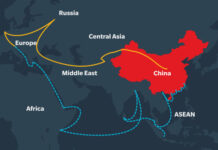The glitzy new mall at Lahore, Packages Mall opened its gates earlier this year and all roads led to it. With all the renowned brands strutting their presence, always fond of lights and a bit of a tamasha, the Lahorites continue to frequent the place in numbers large enough for the Walton Road artery to the Defence to choke on the weekends.
Behind all the shine and the spangle though, the business is not sparkling enough. And, with their bottom lines flashing red, the big brands, in all 60 to 70 of them literally ganged up in October to take on the Mall management to reduce rent and other expenses.

The ever-increasing competition has led brands to resort to frequent sales and discount offers on one pretext or the other. Some brands have gone so far as to permanently reduce their regular prices. All this while costs have hit the ceiling, squeezing margins to well below profitability levels.
Though retailers usually brag about how bad the business is to dodge the taxman, but this incident at Packages Mall was confirmed to Profit by multiple sources and a detailed feedback from the industry suggests the apparel retail sector (read: large brands with high operational costs) is struggling.
Ms Naz Mansha, head of highbrow Nishat Linen – amongst the Top 5 in apparel brands, confirmed to Profit: “The mall management has agreed to consider our request and come up with a viable solution for all, but the final outcome is still pending.”
So we know, the huge stores in the malls are bleeding, but they’re not the only ones. Flagship stores outside of the Malls are having an equally frightful time. The latest casualty was the flagship store of Crescent Lawn in Lahore, bringing the shutters down on the outlet despite having strong financial backing of the Crescent group, owners of Crescent Bahuman and Stoneage brands. Sapphire, another big shot brand by one of Pakistan’s largest textile conglomerate, the Sapphire Group – is said to be losing tens of millions every month, only to inspire an industrialist to shoot one across the bow: “The cone ice cream-wallah at the Main Market corner is doing much better than Sapphire. At least he is making profits compared to the Sapphire Group’s loss-making apparel shops.”

Apprehensive, really apprehensive
And this bolt has come when the big brands were rubbing their hands in anticipation of huge sales, windfall profits and generally rolling in money post the forecast made by the prestigious Bloomberg and Euromonitor. Instead, 10-15 percent decline in profitability is staring them in the face!
The stagnation has for the moment perhaps set in a bout of jitters, if not a sort of panic, clouding the judgement of the brands painstakingly built over the years. Those who have remained at the forefront of retail growth for years are now apprehensive. Really apprehensive.
Not long ago, Profit featured the owners of Khaadi as favourites to become the first fashion billionaires of Pakistan because of a booming business, but sources say that its profits have dropped 15% and sales revenues have tapered off. Almost all the other brands find themselves in a similar dilemma and some even report closing of stores and delays in vendor payments.
In this report, Profit spoke to various stakeholders – the focus being on the non-grocery segment: the millennial shoppers, the movers and shakers of the retail sector, market analysts, and the management of a mall to explore whether the retail sector’s heyday is already over, whether the spending has really slowed down and, if so, why.
We’ll come to the retail slump later, let’s first understand what brought these otherwise booming brands to the mess they find themselves in today.
The big fat sale!
When the clock hit nine on Saturday morning, Nov 11, Aruba Shoaib, a 27-year-old teacher in Beaconhouse School System was still lingering on a jampacked Rashid Minhas Road just opposite Lucky One Mall, where Khaadi was about to start a flat 40% sale as part of a promotion for its newly opened outlet – as is the wont with the country’s largest apparel brand.
It took her another hour to pass two cordons of security, one at the entrance, the other inside, to finally get to the Khaadi’s brand-new outlet, ‘a huge crowd’ was inside already.
A Malir Cantt resident, Shoaib thought she was an early bird. But others apparently had already made a beeline to the outlet early – some thronging it as early as dawn.
What she witnessed gave her a sense of deja vu: pushing and shoving, display tables getting dragged, fights over stock and suffocation – the considerate staff distributing packaged water by way of relief from the mayhem.
After waiting for what seemed an eternity, she made it inside – not by her own volition but pushed in by someone taller and heftier – only to find empty racks. Moving further inside, she found a wall displaying her size and that was it. Shoaib and her sister sat at a corner and shared whatever they got, and then waited another two hours in the queue to settle the bill, Rs25,000 (approximately $250).

Eleven days later a 23-year-old business graduate who requested not to be identified, bought 13 articles from Ayesha-Somaya, a luxury women’s wear brand that went on a 50% flash sale the next day. Unlike Shoaib, she faced less of a hassle because the brand allows its loyal patrons to shop at the discounted price a day before the actual sale begins. She spent Rs80,000 or $800 (approx.), which is almost what an unskilled worker earns in a month in the US (assuming a 30-hour work week with $7.25 per hour being the minimum wage).
Both the school teacher and the business grad belong to a particular class of Pakistanis who are said to be driving the country’s retail boom of late. Both working women are part of a growing middle-class, under-30 (commonly referred to as the millennials), and with higher disposable incomes.
A recent Bloomberg report identified this group as millennial shoppers, who are two-thirds or 135 million of the country’s burgeoning population that is keen to live in style without bothering too much about the price tag – the exact opposite of the ‘Baby Boomers’ generation whose hallmark was its inclination to save.

Based on a research by Euromonitor, the report also identified Pakistan as the world’s fastest growing retail market, predicting an annual expansion of 8.2% throughout the period ending 2021 with the retail stores to increase by a half to one million during the period.

The personal accounts of those who endured the pain to part with $200 or more during the 40-hour bonanza tell a different story than what Euromonitor’s research unveiled in September. The “millennial shopper” is not buying clothes at full price and seems to have restricted spending at sales only. They seem to buy in bulk during sales but curtail spending during the remainder of the year. This, by most accounts, has been the trend since mid-2016. And that has been a cause for concern to almost all the retailers surveyed for this report.
The overhyped millennial
“It’s not at all wise to shop at full price when the same stuff is available online as well as during sales,” Shoaib, the BSS teacher said. “We do buy things on regular price from outlets which hardly go on sale, but buying from Khaadi, Outfitters, J. and Gul Ahmed on face value is not sensible since sales are offered often,” she said.
 The school teacher cum home-based entrepreneur says she visits malls to select the articles she wants and when the particular brand goes on a big sale either physical or online, she buys her selection.
The school teacher cum home-based entrepreneur says she visits malls to select the articles she wants and when the particular brand goes on a big sale either physical or online, she buys her selection.
The business graduate quoted above seems to have a similar habit. “I buy an ensemble on full price only if I need it,” the 23-year-old told Profit. In fact, it is not just millennials who have restricted their ‘big spending’ to fat sales. Ambreen Khalid, a 45-year-old resident of Gulshan e Iqbal, for instance, waits for sales because that’s when “I pick up the high-end brands stuff, otherwise too overpriced and unaffordable’. She treated herself to goodies worth Rs29,000 ($290) during the Lucky-One-Mall Khaadi sale.

Shehzad Elahi, the CEO of Lahore-based Kids and Ladies wear brand Mushrooms, attributes this particular attitude to the seasonal discounts offered by brands. “If a brand puts up a discount offer for the winter season, customers buy more than they would buy at a normal price, but then next year they will already have enough stock of clothes so they won’t buy more,” he says.

Though largely observed in the apparel sector, for the footwear this trend may also hold, and the premise is endorsed by one of the largest footwear brands in the country.
“Customer’s attitude towards purchasing is largely dependent on pricing attributes,” says Javed Iqbal Siddiqui, the CEO of Lahore-based Stylo Group, a popular footwear brand that caters to a wide range of cstomers mainly from the middle-income segment. “As seasonal offers and discounts are very common, it restricts people to make purchases during non-sale days. That is why the customers always wait until sale starts,” Siddiqi says – and that is exactly what we find in case of recent sales at Karachi’s Lucky One Mall.
The Khaadi sale brought customers out in droves to an otherwise deserted mall. The mall’s admin claims more than 300,000 people visited them during 40 hours the sale was on – if correct, this translates to 125 visitors per minute. However, it also endorsed the feedback Profit received from the market. That is how a big sale by one known brand triggers a frenzy as others follow, resulting in a sales war.
For example, Shoaib, the teacher, recalls when she entered the mall no other brand offered any promotion, but later in the day almost everyone followed suit and these also include the likes of J., and Gul Ahmed. “Every other person was roaming around with Gul Ahmed’s pillows in their hands,” she said – according to the mall’s admin more than 90% of the brands went on sale during that period.
“The traffic on Saturday was massive and in no way comparable to what I witnessed here on the eve of Eid ul Fitr,” said Shoaib who also visited the same mall on the eve of the annual Islamic festival and by far the biggest shopping occasion – she didn’t buy any suit on Eid-ul-Fitr, but spent Rs38,000 on the Black Friday sale just last week. Even the food outlets offered several discounts to cash in on the huge footfall, something that this less-than-a-year-old mall is not used to, she recalls.
And the sales frenzy didn’t stop there. The following week Agha Noor and Sana Safinaz, both high-end brands, also offered 50% and 70% flat sale for Saturday, Nov 18 – that, too, in Lucky One Mall, which again attracted big crowds.
The big Malls
Lucky One Mall’s CEO, Sohail Tabba recently told Business Recorder, that Karachi needs at least 30 malls. However, Lucky One Mall, one of the biggest in the country, has not been able to pull the crowd it was anticipating – similar to what happened at Packages in Lahore but contrary to the norm where a new mall enjoys an early honeymoon period.
The back-to-back weekend sales (not counting the Black Friday weekend) offered by Khaadi, Sana Safinaz, Agha Noor and later by Gul Ahmed ensured higher footfall in the mall but at the same time challenged the notion that it’s the malls that attract large crowds and as a result tenants (retailers) benefit in terms of higher sales.
Though business tycoons like Tabba are optimistic about the future of malls, as evident from his statement, market experts seem to have a different take on that notion.
“Our research has shown that the number of people visiting Packages Mall is very low and not comparable to any other big mall like Emporium or The Centaurus Mall,” says Ahmed Muzzamil, CEO of Footmetrics.
 Footmetrics is a data analytics company that installs technological equipment inside shops to gather data on customers visiting a particular shop. It includes demography, age group, time spent inside a shop, number of items bought, specific items bought and time of day with the highest number of visitors.
Footmetrics is a data analytics company that installs technological equipment inside shops to gather data on customers visiting a particular shop. It includes demography, age group, time spent inside a shop, number of items bought, specific items bought and time of day with the highest number of visitors.
“The people here are accustomed to run after anything new that hits the market and the same happened with malls… They bring their guests along to just lounge in the mall. They don’t buy anything, don’t spend on food, but just treat the mall as their drawing room”, Muzzamil says, adding, he has personal accounts of tenants from Lucky One Mall that suggest the mall is situated in an area where people don’t have facilities like electricity, air conditioning or WiFi.
Muzzamil further said, the retailers are worried, but it is happening because the location wasn’t taken into account for its impacts on business later – Ammar Motan of Lucky One Mall disagrees.
“About 10 million people live within the 10-kilometer radius of the mall,” Motan said – that would mean about half of Karachi’s population lives in that vicinity. People of these areas have higher purchasing power, he said in an apparent reference to the localities of Nazimabad, Gulshan-e-Iqbal, and Gulistan-e-Jauhar that are inhabited by the growing middle-class families.
“A new mall has about 6 to 8 months honeymoon period; after that, traffic invariably slows down. A new mall takes time to evolve,” he said but, he quickly added a rider, a 70% plus retention rate means majority of their customers were ‘repeat’ visitors.
Asked if their tenants have raised concerns similar to the complaints of those operating at the Packages Mall, Motan referred us to the Mall’s executive director, who did not respond to our queries in time.
Both Packages and Lucky One are two of the latest entrants in the country’s high-end malls segment and commenced operations amid reports of a retail boom, but majority of the retailers we spoke to complain about their high operational costs, which are difficult to meet, especially amid cut-throat competition and a sales war that has already squeezed their margins.
The whys of the retail slump
While most retailers, especially the big brands that have a nationwide presence, concede that their turnover has stagnated and profits declined, more than one theory has emerged to explain these phenomena.

“People mostly come to enjoy the movies and food in addition to the comfort of a fully air-conditioned environment. They are mostly window shoppers, not the actual customers,” Siddiqui of Stylo says. The chief of Stylo, which has a presence in every major mall, notes that sales can’t increase on a similar scale as expenses do.
The sector-wise data is not available, but Khaadi estimates the cost of operating an outlet in a mall is 40% higher than that of a standalone store. “Increased operational costs and cut-throat competition are the prime reasons for this [lower sales],” says Naz Mansha, Owner of Nishat Linen, leading women wear brand and a subsidiary of Nishat Textile Mills. “And the customers who buy ready-to-wear ranges are now opting for western rather than eastern designs”, she explained.
“Rentals, overheads, labor and other costs have increased remarkably in the last few years. Malls’ rents have gone up and the bigger the shop the higher the price,” says Schalim Reuben, CEO of EGO, a stitched clothing brand for women that has nation-wide presence in the retail sector. “
SEFAM, a manufacturing and retailing brand for embroidered and designer fabrics that has now grown to a family of 12 brands including Bareeze, Leisure Club, Minnie Minors, and Kayseria to name a few, identifies rising competition as the main reason. “Almost everyone in Pakistan wants to make a name for themselves and many try to do that through launching their clothing brand. So the competition is the primary reason for many brands experiencing a downfall,” says Omer Chaudhary, General Manager at SEFAM.
Some retailers also argue that the overall market is not shrinking. For example, Reuben of EGO says, “the size of the pie has increased in recent years, but the individual share size of brands has shrunk,” – though all retailers are relying on anecdotal evidence as no data is available to find out an accurate picture.
In its first six years, EGO doubled its business every year, but that’s not the case any more, Reuben noted adding, “The industry has grown so big with new brands opening up every day, customers have a lot more options now.”
EGO’s CEO says the industry is somehow booming and there is potential and people want to do business. “If that was not the case you wouldn’t see all those brands that opened up last year or those opening soon,” he adds, but noted only certain markets` or locations would businesses to be profitable. Otherwise, he said one would keep paying overheads and costs, but not receive the same business.
Mushrooms, a clothing brand for kids, has a similar view. Shehzad Elahi, its CEO says there are no figures available for industry wide comparisons, it’s all just personal judgment. “If someone says that the retail sector is going down, it is probably only because their brand is experiencing negative growth,” he said.
Elahi said when one brand puts up a discount sale offer to take share from another brand, the latter also drops prices in a bid to recover the lost share so the end effect is that the sales volume remains the same but the value drops. “If you look at the apparel industry, prices today are considerably lower than what they used to be a few years ago,” he said.
Amid reports of a retail boom, more players are setting up business or expanding their store network, but not everyone has fat margins like in the past. While the most common explanation is the increased competition and a sales war but there are a few other very plausible theories as well. For example, Gul Ahmed attributes the recent decline in consumer spending to the political uncertainty in the country, which has caused consumers to switch to savings mode, but Muhammad Usman of Khaadi while agreeing with the political uncertainty theory, blames mostly a year-round sales culture for causing a slowdown in spending.
“Other than Khaadi, retail industry is getting into a vicious cycle of discounting which is hurting brand equities and structural economics of most of the brands. With this kind of discount selling only brands with efficient supply chains will survive. On the positive side, I see the size of the branded market increasing as more and more customers will switch to brands because of affordability. Fashion products are becoming generic and moving towards commoditization. More and more millennials are entering their independent shopping age and loyalty is diminishing which is making the job tougher for brands to differentiate on the basis of just fashion. Successful brands need to invest in understanding buying behaviors of these millennials and GenZs as without understanding every touch point of their lives it will be difficult for brands to survive,” says Usman, the Khaadi’s marketing head.

Usman, however, was quick to add: there are other factors at play that may be linked to the recent slowdown in spending. For example, he said a lot of this boom and growth was tied to real estate sector but the government has tightened its policies on that front. This is where a lot of cash was coming from but that’s not the case anymore.
Real estate accounts for two-thirds of the world’s total wealth, and when it booms, it moves the entire economy but Pakistan’s real estate sector got a major hit earlier this year when the government increased property valuation rates in all major cities to collect higher taxes from the sector.
That said, not all retailers agree on this theory. For example, Siddiqui of Stylo says, real estate sector doesn’t directly affect the retail customers because the former represents investors and the latter are people with relatively low disposable income.
What Next?
Experts believe this is a cycle, which the industry has put itself into and will pull itself out of too, and no external working is required for that – some retailers agree with this view, others opine a government intervention or collaboration among retailers could save the day.

“The brands need to form forces and assemble at a joint forum to improve this situation. A joint effort can go a long way for the industry,” says Naz Mansha of Nishat Linen and she is seconded by SEFAM’s Omer Chaudhary.
The good thing that came out of the protest at Packages Mall was that retailers came together as a united body, Chaudhary said. “Some malls only look to make quick gains, but by coming together retailers at least formed a united front that allowed them to communicate their concerns in a better way. The protest didn’t result in reduction of rents, but the management extended some slack on the top up expenses and resolved the issues,” he said.
However, he noted, it will take more than collaboration to deal with the situation. For example, he said, that focus needs to shift to building brands instead of more shops. “Values and philosophy have to be added to provide consumers an emotional and physical experience.
“If it is only lower prices attracting customers than any other brand with even lower prices will take those customers away. But if there are more than just products and prices, and there is an emotional connection for the customers, they will remain loyal.
“We have been focusing on our efficiency and consolidation for almost the entire past year. We have been evaluating closely where our strengths lie, where and when we can push and how we can achieve sustainable growth, and add more top ups in terms of experiences for customers.” said Chaudhary
Others believe government intervention can be useful. Among them is CEO of Stylo who says the government should put a slab on rentals in malls and standalone places, give rebate in taxes and duties, reverse the recent increase of 35% in duties, and ease the process of importing raw material and finished goods to support retail, which is the second largest industry.
A few retailers say the apparel segment of the retail sector is in transitory stage, but not all of them see the government’s role in healing the self-inflicted wounds of the sector.
Retail market has six stages of lifecycle, mom and pop stores, standalone outlets, shopping centers, malls, online stores and Omni retailing (Bricks & Mortar + Online). Pakistan is currently in the transitory stage of Malls and Online, according to Usman of Khaadi.

Retail costs have significantly gone up due to customer’s transition to Malls where operating costs are almost 40% higher than a standalone store. Looking at the Malls lifecycle in any retail market it takes approximately a year to a year and a half for a Mall to drive healthy revenues for 70 to 80% of its occupants. All these new malls including Packages, Emporium, WTC, and Lucky will follow the same trajectory, he said.
However, things seem to be dismal in the foreseeable future if the current practice of year-round sales doesn’t stop. For all brands, the next two to three years will remain quite critical, said the operations manager of an apparel brand, requesting we don’t identify him because he is not authorized to comment. And those who flocked to set up shop to ride the ‘boom’, he predicts, wouldn’t get the anticipated result due to saturation in the market. Especially, smaller brands would not be able to sustain the competition this industry is offering at the moment and will shut down in the next few years, he said.
“So when all these ‘shoqia’ brands wrap up, only then, one can comment on the actual situation of the retail sector,” he said.
























Bloomberg is wrong and Profit is right, because Naz Mansha, owner of Emporium says so?
Okaye! A multi million mall in Islamabad is understandable owing to absence of a shopping facilities for class concious people. But 4-5 Malls in succession in Lahore is utter madness. Bahria Park Lane or Fortress square is bit manageable on overheads but packages and Emporium too big to be profitable unless they introduce New stuff like snow skate, Karting or other experiences!
Nice write up and analysis but it’s not at all important to use difficult words in the article.
Reading this report I got the feeling that perhaps the conclusion had been made (Pakistan’s retail sector has gone ‘bust’) even before the research took place. And then whatever research was done was written up to suit the conclusion. To start with, the title – ‘How Pakistan’s retail sector went from boom to bust?’ Bust to me means zero. Broke. So is the retail sector in decline, even at a low ebb or is it bust, as in zero? Second, and possibly again because the conclusion was reached first and then research followed, things have been mixed up. The sub-heading states: ‘Contrary to Euromonitor’s recent research that identified Pakistan as the world’s fastest growing retail market, Profit’s own investigation reveals that fashion retailers are increasingly facing falling revenues….’. Was Euromonitor’s research limited just to fashion retail? If not and it covered the broader retail sector, then how can it be compared to Profit’s narrow focus research of fashion retail? And from this comes my third observation – does Profit see fashion retail, and even that limited to 3 or 4 brands covered in the Report, as the vast bulk of Pakistan’s retail sector? If you take the monthly retail spending of Pakistanis, even millennials, what percentage of the total monthly spend is on fashion garments, month after month? A single digit percentage, I dare to say. Typically millennials major retail spend is on several other things. Like technology and gadgets, eating out, entertainment, personal grooming, fitness, travel.
Good point. Retails always seems to equated to only women’s fashion retail in Pakistan. There are numerous other retail categories, that are ignored
Khaadi is mainly responsible for this disaster of this industry.
That Ma’am, is a classic loose statement. What disaster? How is Khaadi or anyone else ‘responsible’. I think when anyone makes such a huge generalization, it should be backed by a solid rationale, facts, figures and a clear reasoning.
I think consumers are just getting a lot smarter in terms of their purchasing habits.
I am of the opinion though retail industry as whole is in crises but it has mostly affected giant brands having Large stores, Meeting huge stores’ expenses & reducing margins have put them in such condition whereas small brands with small shop sizes are enjoying even in this period but only those who are with good/effective planning. So it’s an opportunity for small brands to show their presence and capitalize. I foresee a tough competition ahead but on other hand bright retail future but that is not possible without updated effective planning & having online presence which is going to be mandatory specially for small brands.
Where are the revenue/profit figures. All I can read is just a lot of whining about falling revenues and increased costs by the incumbents, who can’t handle the rapidly changing retail industry.
I agree with the points written but wanted to share the strengths of Pakistan.As a Pakistani ,we never acknowledge negatives ,we always like growth ,more retail setup s & more jobs/opportunities in Pakistan.
I just got to read this article. While it is not backed by data, many conclusions about apparel retail in Pakistan are correct. And this is not just about Pakistan. Apparel retail is suffering almost everywhere in the world and forced to down-price their price every now and then.
There is an over-supply of brands. At the same time, people are spending more on experiences (travel, dine-out) and gadgets (mobiles and tablets) than on high-end clothing. You can see a fully-occupied food-court in every mall and cinema business is thriving.
This trend is here to stay. Over time many small brands will bow out, bigger ones will restructure and re-focus.
Comments are closed.